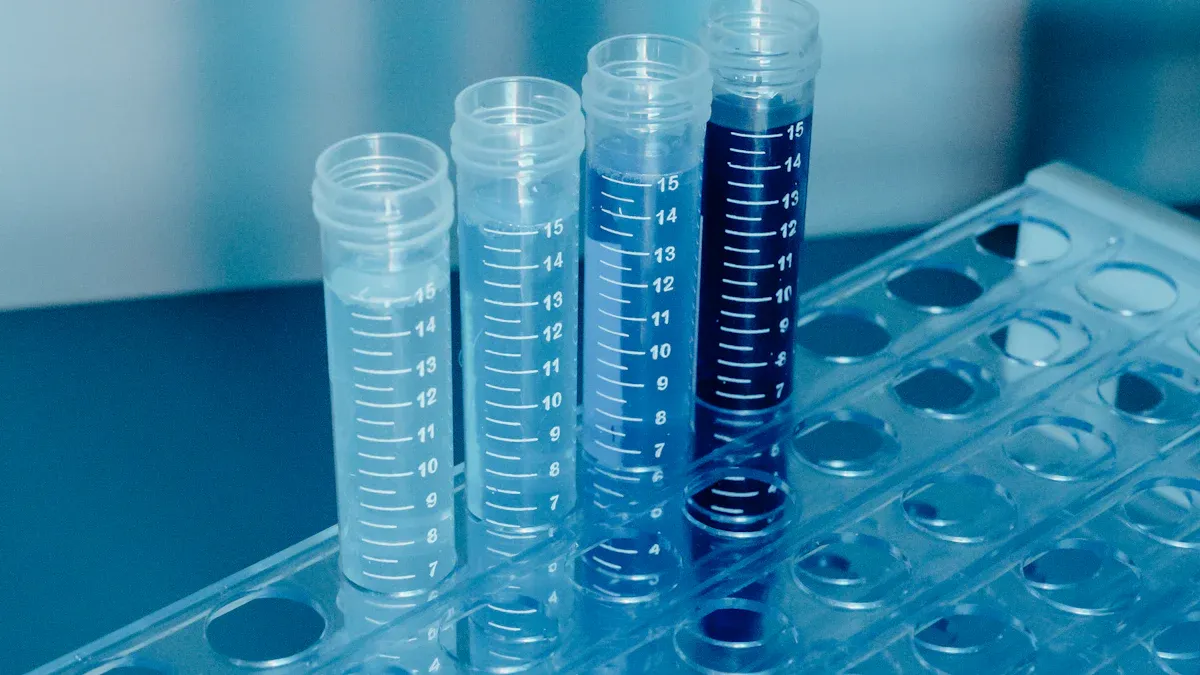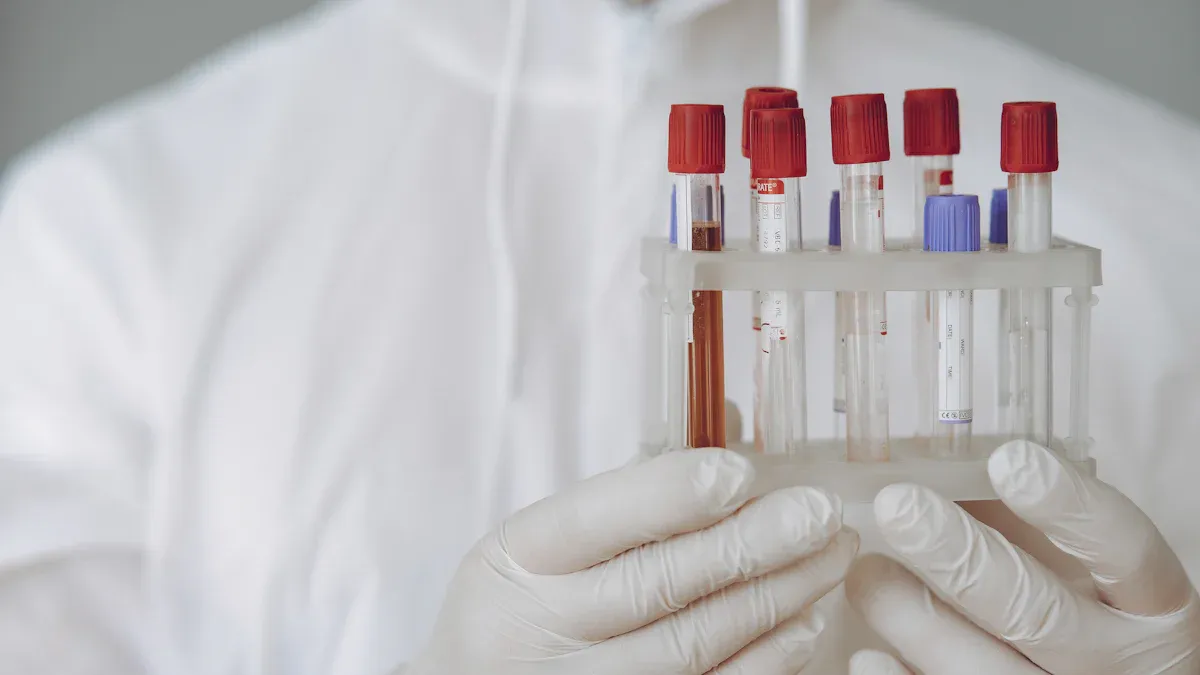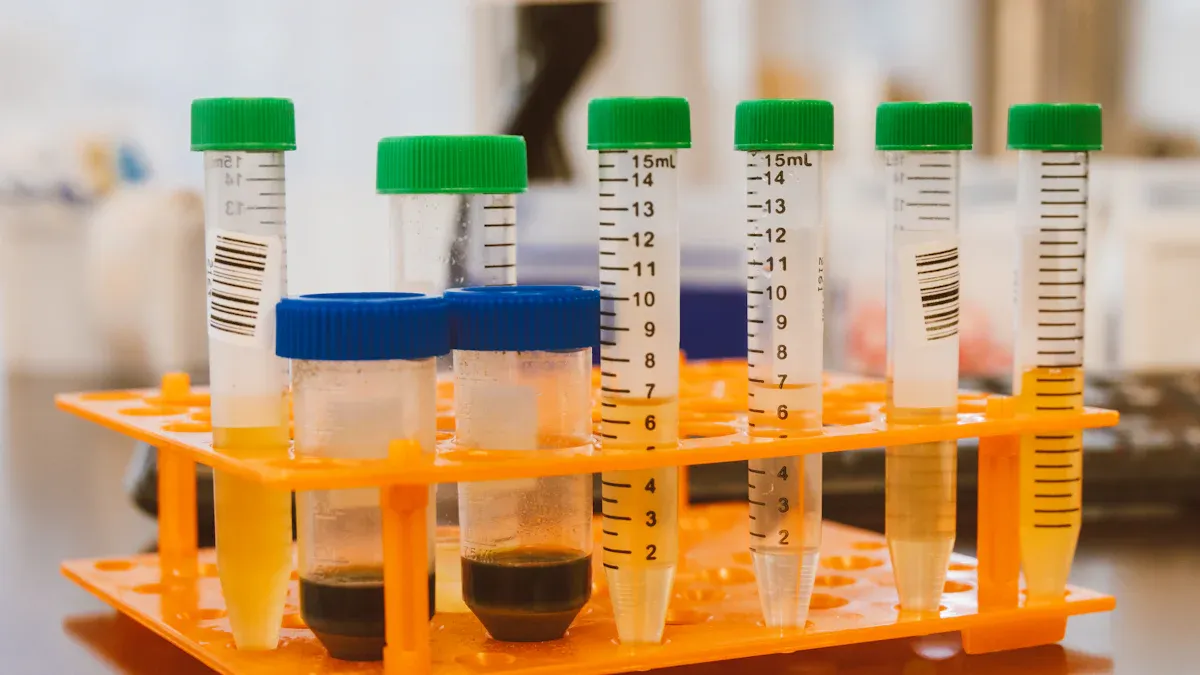News & Events
Top Tips for Choosing the Right Centrifuge Tube Rack for Western Blot Samples

Choosing the right centrifuge tube rack can make your sample work much easier in the laboratory. You want a rack that fits your workflow and keeps everything organized. Think about how each feature will help you handle your centrifuge tube with less stress and fewer mistakes. Ask yourself what problems you face during Western blot prep and how a new rack could solve them.
Key Takeaways
- Choose a centrifuge tube rack that fits your tube sizes snugly. This prevents spills and keeps your samples organized.
- Select a durable material like polypropylene for your rack. This ensures longevity and resistance to chemicals.
- Consider the number of samples you process regularly. Pick a rack that accommodates your busiest days with extra slots for unexpected samples.
- Look for racks with adjustable slots or modular designs. This flexibility allows you to switch between different tube sizes easily.
- Ensure your rack is compatible with your centrifuge model. A secure fit prevents accidents and protects your samples.
Why the Right Centrifuge Tube Rack Matters
Impact on Sample Processing
When you work with Western blot samples, you want everything to run smoothly. The right centrifuge tube rack helps you keep your samples safe and organized. You can place each centrifuge tube in its own spot, so you never mix up your samples. This makes sample processing much easier. If you use a rack that fits your tubes well, you lower the risk of spills or drops. You also avoid cross-contamination, which can ruin your results.
Tip: Always check that your laboratory rack matches the size of your tubes before you start processing. This simple step can save you from big mistakes later.
If you pick the wrong rack, you might lose a sample or even damage your centrifuge. You could also waste time searching for the right tube. These problems slow down your work and can lead to errors in your results.
Workflow Efficiency
A good rack does more than just hold tubes. It helps you move quickly from one step to the next. You can grab the tube you need without searching through a messy bench. This keeps your laboratory neat and helps you focus on your experiment.
Here’s how the right rack boosts efficient sample processing:
- You can process more samples at once.
- You spend less time setting up and cleaning up.
- You avoid mistakes that come from poor organization.
If your rack fits your centrifuge, you can spin your tubes without worry. You know your samples will stay in place. This means you get reliable results every time. When you choose the right rack, you make your whole laboratory workflow better.
Identify Centrifuge Tube Types

Microcentrifuge Tubes
When you set up your Western blot, you probably reach for microcentrifuge tubes first. These small tubes are a staple in any laboratory. Most microcentrifuge tubes hold between 0.5 mL and 2.0 mL. You will find that 1.5 mL tubes are the most common choice. They work well for most molecular biology tasks. Some brands even make 1.5 mL tubes that can actually hold up to 1.7 mL, giving you a little extra space if you need it. This extra capacity can help when you have a sample that needs just a bit more room.
Tip: Always check the actual capacity of your microcentrifuge tube. Sometimes, the marked volume is less than what the tube can really hold.
You want a rack that fits these tubes snugly. If the rack is too loose, your tubes might tip over. If it is too tight, you could struggle to get the tubes in and out. A good fit keeps your samples safe and makes your workflow smoother.
Multiple Tube Sizes
You may need to use more than one type of centrifuge tube during your experiment. Some steps in Western blotting require larger conical centrifuge tubes, like 15 mL or 50 mL sizes. These tubes are perfect for mixing buffers or holding larger volumes. If you switch between microcentrifuge tubes and conical centrifuge tubes, you need a rack that can handle both types.
Here’s a quick way to check if your rack fits your needs:
| Tube Type | Common Sizes | Best Use Case |
|---|---|---|
| Microcentrifuge tube | 0.5–2.0 mL | Small volume sample prep |
| Conical centrifuge tubes | 15 mL, 50 mL | Buffer mixing, large volumes |
If you work with different tube sizes, look for racks with adjustable slots or modular designs. This flexibility saves you time and keeps your bench organized. You will not need to hunt for a new rack every time you change your workflow.
Choose Laboratory Rack Materials
Durability and Safety
When you pick a rack for your Western blot samples, you want something that lasts. You do not want to replace it every few months. Some racks break easily, while others can handle daily use in a busy laboratory. You should look at the material before you buy. Here is a quick table to help you compare the most common materials:
| Material | Advantages | Disadvantages |
|---|---|---|
| Polypropylene | Durable and shatterproof Chemically resistant High-speed centrifugation Various sizes available | Higher cost Not for low temperatures Some compatibility issues |
| Polystyrene | Low cost Transparent Low binding properties Works with many reagents | Less durable May deform under high forces Less chemical resistance |
| Polyethylene | Flexible Autoclavable Chemically resistant Good for low temperatures | Not for high-speed centrifugation Higher protein binding Can deform |
If you want a rack that can handle bumps and drops, polypropylene is a strong choice. It does not shatter and can hold up to a lot of use. Polystyrene racks cost less, but they might crack or bend if you use them a lot. Polyethylene racks work well if you need something flexible, but they do not do well with high-speed spins.
Tip: Always check the tube capacity of your rack. You want to make sure it fits the number and size of tubes you use most often.
Chemical and Temperature Resistance
You often work with chemicals and heat in the laboratory. Your rack should not melt or react with your samples. Some racks can handle strong solvents, salts, and even weak acids or alkalis. Others might break down or stain if you use harsh chemicals.
Here is what you should look for:
| Property | Details |
|---|---|
| Chemical Resistance | Stays strong with organic solvents, salts, acids, alkalis |
| Temperature Range | -223ºC (-369ºF) to 121ºC (250ºF) |
| Autoclavable | Yes |
If you need to sterilize your rack, make sure it is autoclavable. Polypropylene and polyethylene racks usually work well in an autoclave. Polystyrene racks might not survive the heat. Always match your rack to your laboratory needs so your samples stay safe.
Rack Size and Capacity

Number of Samples
You want a laboratory rack that matches the number of samples you handle every day. If you process just a few tubes, a small rack works well. If you run big experiments, you need a rack that holds more tubes. Think about your busiest days in the laboratory. How many centrifuge tube slots do you need at once?
Here’s a quick guide to help you decide:
| Number of Tubes | Best For |
|---|---|
| 6–12 | Small experiments |
| 16–24 | Medium sample sets |
| 30+ | High-throughput labs |
A rack that fits your workflow helps you keep track of every sample. You avoid crowding and reduce the risk of mixing up tubes. This makes sample processing much smoother and supports efficient sample processing.
Tip: Always choose a rack with a few extra slots. You never know when you’ll need to add another sample!
Flexible Layouts
Not every experiment looks the same. Sometimes you need to switch between different tube sizes or change your setup. Flexible layouts make your life easier. Some racks have adjustable slots or removable dividers. You can fit both small and large tubes in the same laboratory rack. This saves space and keeps your bench tidy.
You might want to look for racks that stack or connect together. This way, you can build the setup you need for each project. Flexible racks help you stay organized and ready for any processing challenge.
Note: A flexible rack lets you adapt to new protocols without buying new equipment. This saves money and keeps your laboratory running smoothly.
Compatibility with Centrifuge
Secure Fit
You want your centrifuge tube rack to fit perfectly inside your centrifuge. A secure fit keeps your samples safe during spins. If the rack wobbles or shifts, you risk spilling your samples or breaking tubes. You can avoid these problems by checking a few things before you start sample processing.
- Pick centrifuge tubes that match the speed you plan to use. Tubes that are too small or too big can spill or break.
- Make sure every tube is in good shape. Look for cracks or chips. Fill each tube no more than three-quarters full. This helps prevent spills when the centrifuge spins.
- Place each tube snugly in the rotor. If the tube feels loose, try a different slot or tube size.
- Seat the rotor firmly on the spindle. A loose rotor can cause accidents.
Tip: Always double-check the fit before you start your experiment. A few seconds can save your samples and protect your laboratory equipment.
Model Matching
Not every rack fits every centrifuge. You need to match your rack to your centrifuge model. Manufacturers design racks for specific rotors and tube sizes. If you use the wrong rack, you might damage your centrifuge or lose valuable samples.
Here’s a simple table to help you match your rack to your centrifuge:
| Centrifuge Model | Compatible Rack Type | Tube Size Supported |
|---|---|---|
| Mini Centrifuge | Compact rack | 0.5–2.0 mL |
| Standard Rotor | Universal rack | 15–50 mL |
| Swinging Bucket | Modular rack | Multiple sizes |
You can check your centrifuge manual or ask your supplier for advice. Matching the right rack to your centrifuge keeps your workflow smooth and your sample processing reliable.
Note: If you change your centrifuge or tube type, update your rack. This keeps your laboratory safe and organized.
Features for Sample Organization
Labeling Options
You know how easy it is to lose track of your samples when things get busy. Good labeling options on your laboratory rack can save you from a lot of confusion. Look for racks with clear, numbered positions. This way, you can match each tube to your notes without guessing. Some racks even have two levels, which helps you organize your samples by step or experiment.
Here’s what you might find helpful:
- Numbered tube positions (like 1 to 20) make it simple to spot the right sample.
- Two levels give you more space and help you separate different groups of samples.
- Wide spacing lets you see labels clearly and grab the tube you need fast.
Tip: Always write your labels before you start your experiment. This habit keeps your workflow smooth and helps you avoid mistakes.
Easy Access and Spill Prevention
You want to reach your samples quickly, but you also want to keep them safe. The best racks use smart designs to help you do both. Check out this table to see what features make a difference:
| Design Element | Description |
|---|---|
| Stability Features | Stops tubes from rotating, so you spill less and keep everything steady. |
| Easy Access Designs | Lets you open and close lids with one hand, so you work faster. |
| Well Spacing | Gives you room to load tubes with or without pipette tips, making things easier. |
Many racks are molded from strong polypropylene. This material stands up to chemicals and is easy to clean. Some racks have non-skid rubber feet, so they stay put on your bench. You can even use some racks in water baths or turn them different ways to reach your samples better.
- Molded from durable, autoclavable polypropylene
- Non-skid rubber feet for stability
- Chemical-resistant and easy to clean
When you pick a laboratory rack with these features, you make your laboratory safer and your work much easier.
Maintenance and Cleaning
Cleaning Protocols
You want your centrifuge tube rack to last a long time and keep your samples safe. Cleaning your rack the right way helps you do both. Start by removing all tubes and any visible debris. Use warm water and a mild detergent to wash the rack. Scrub gently with a soft brush to reach every corner. Rinse the rack with distilled water to remove any soap.
If you need to sterilize your rack, check if it is autoclavable. Polypropylene and polyethylene racks usually handle autoclaving well. Place the rack in the autoclave at 121°C (250°F) for 15–20 minutes. Let it cool before you use it again. If your rack cannot go in the autoclave, use a 70% ethanol solution to wipe it down. Let it air dry on a clean surface.
Tip: Clean your rack after every experiment. This habit keeps your laboratory organized and your samples safe.
Preventing Contamination
You want to protect your samples from cross-contamination. Always wash your hands before you handle the rack. Wear gloves if you work with sensitive samples. Store your rack in a clean, dry place when you are not using it. Avoid stacking dirty racks on top of clean ones.
Here are some easy steps to keep your rack free from germs:
- Disinfect the rack before and after use.
- Use separate racks for different experiments if possible.
- Label each rack clearly to avoid mix-ups.
A clean rack helps you keep the integrity of your results. You can trust your data when you know your samples stayed safe from outside germs. Good cleaning habits make your laboratory a better place to work.
Quick Checklist for Rack Selection
Ready to pick the best laboratory rack for your Western blot samples? Use this checklist to make sure you cover all the important points. You can print it out or keep it on your phone for quick reference in the laboratory.
-
Tube Type
Check which tubes you use most often. Microcentrifuge tubes? Conical tubes? Make sure your rack fits them snugly. -
Material
Look for racks made from strong materials like polypropylene. These last longer and resist chemicals. If you need to autoclave, double-check that the rack can handle high heat. -
Capacity
Count your samples. Do you need space for 6, 12, or 30 tubes? Pick a rack that matches your busiest days. -
Layout
Choose a rack with adjustable slots or removable dividers if you switch between tube sizes. Flexible layouts help you stay organized. -
Compatibility
Match your rack to your centrifuge model. Check the manual or ask your supplier if you are unsure. -
Labeling
Find racks with clear numbers or spots for labels. This makes it easy to track your samples. -
Access and Safety
Look for racks with non-skid feet and wide spacing. These features help prevent spills and make it easier to grab tubes. -
Cleaning
Make sure you can clean and disinfect your rack easily. Autoclavable racks save time and keep your samples safe.
Tip: If you are not sure about a feature, ask a colleague or check with your supplier. You want a laboratory rack that fits your workflow and keeps your samples safe.
Here’s a quick table to help you compare features:
| Feature | What to Check |
|---|---|
| Tube Fit | Snug, no wobble |
| Material | Polypropylene, autoclavable |
| Capacity | Enough slots for your needs |
| Layout | Adjustable, flexible |
| Compatibility | Matches centrifuge model |
| Labeling | Numbered, easy to read |
| Safety | Non-skid, spill prevention |
| Cleaning | Easy to wash, disinfect |
You can use this checklist every time you buy a new rack. It helps you avoid mistakes and keeps your laboratory running smoothly.
You now have the top tips for picking the right centrifuge tube rack for your Western blot samples. Use the checklist next time you shop for new equipment. Careful rack selection helps you keep your laboratory organized and protects the integrity of your results. If you have questions, talk with your colleagues or reach out to your supplier for advice. Smart choices make your workflow smoother and your experiments more reliable.
FAQ
What size centrifuge tube rack should I buy for Western blot samples?
You should pick a rack that matches the number of samples you process most days. If you run big experiments, choose a rack with more slots. Always leave a few extra spaces for unexpected samples.
Can I use the same rack for both microcentrifuge and conical tubes?
Some racks fit both types, but not all do. Look for racks with adjustable slots or modular designs. Check the product details before you buy. This helps you avoid mix-ups and keeps your workflow smooth.
How do I clean my centrifuge tube rack safely?
Remove all tubes first. Wash the rack with warm water and mild soap. Use a soft brush for corners. If your rack is autoclavable, sterilize it in the autoclave. Let it dry before using it again.
Why does rack material matter for Western blotting?
Rack material affects durability and safety. Polypropylene racks last longer and resist chemicals. Polystyrene racks cost less but break easily. Always match the rack material to your laboratory needs for best results.
What should I do if my rack does not fit my centrifuge?
Stop and check your centrifuge manual. You may need a different rack or adapter. Using the wrong rack can damage your centrifuge or cause spills. Ask your supplier for help if you are unsure.

